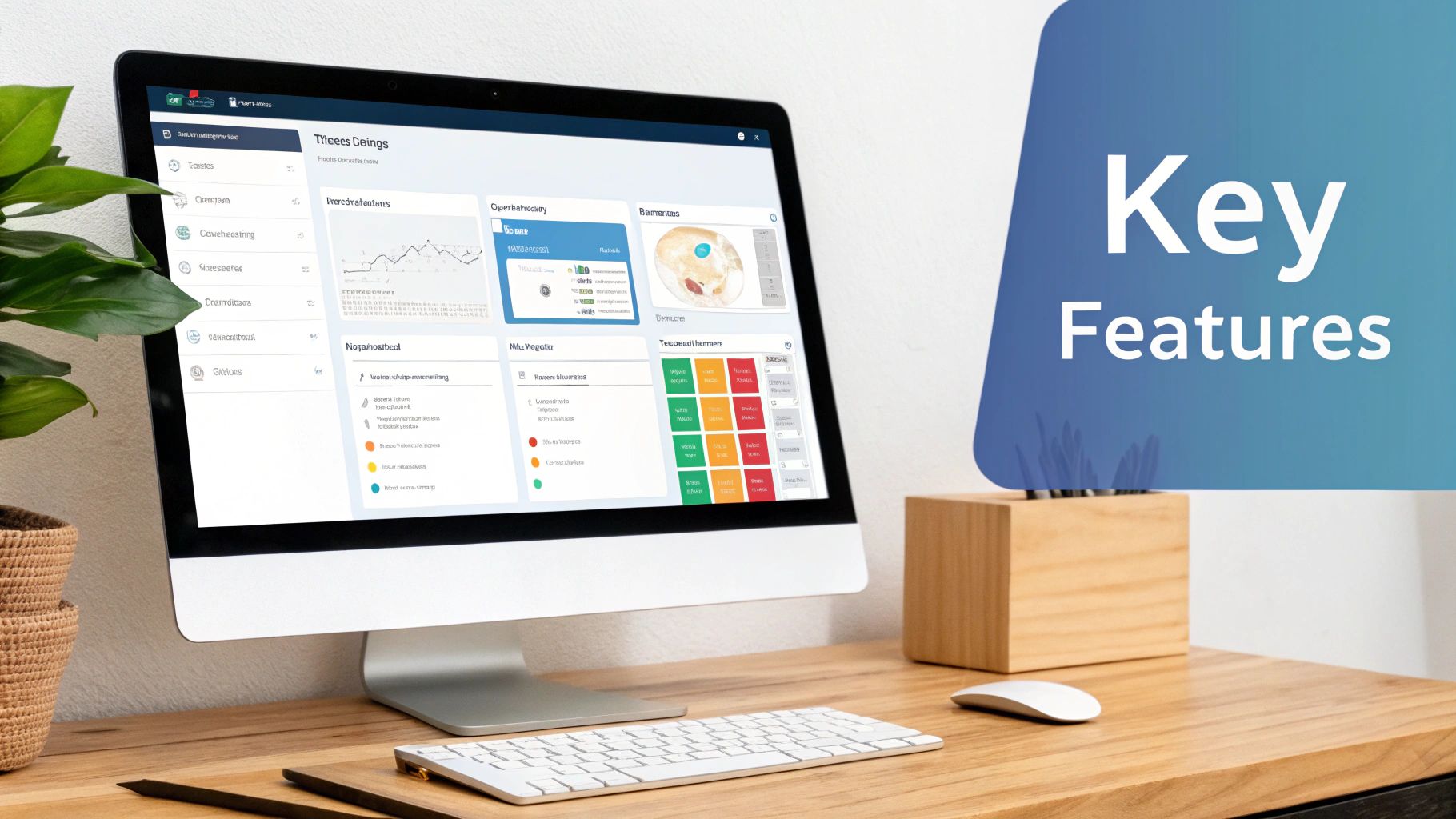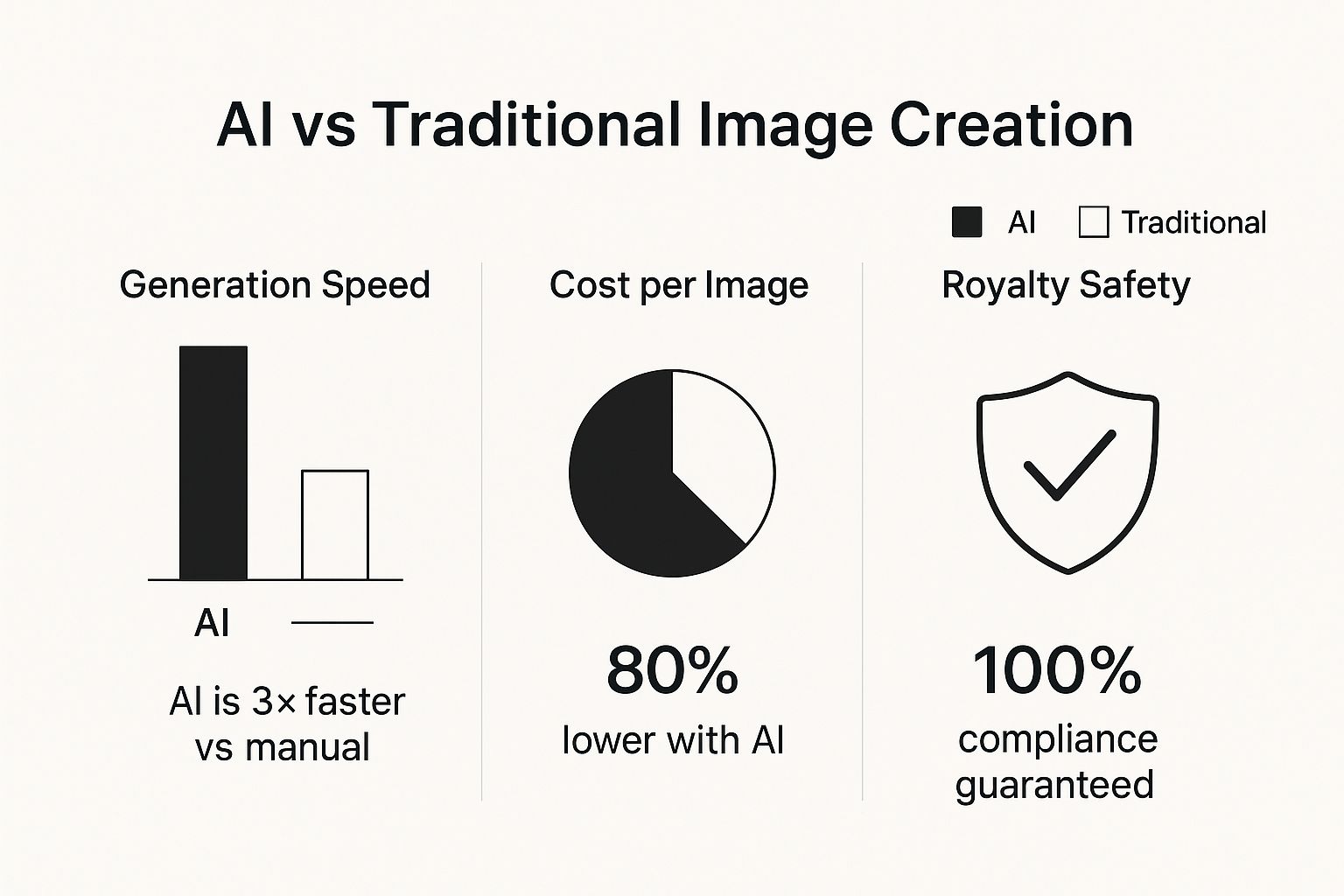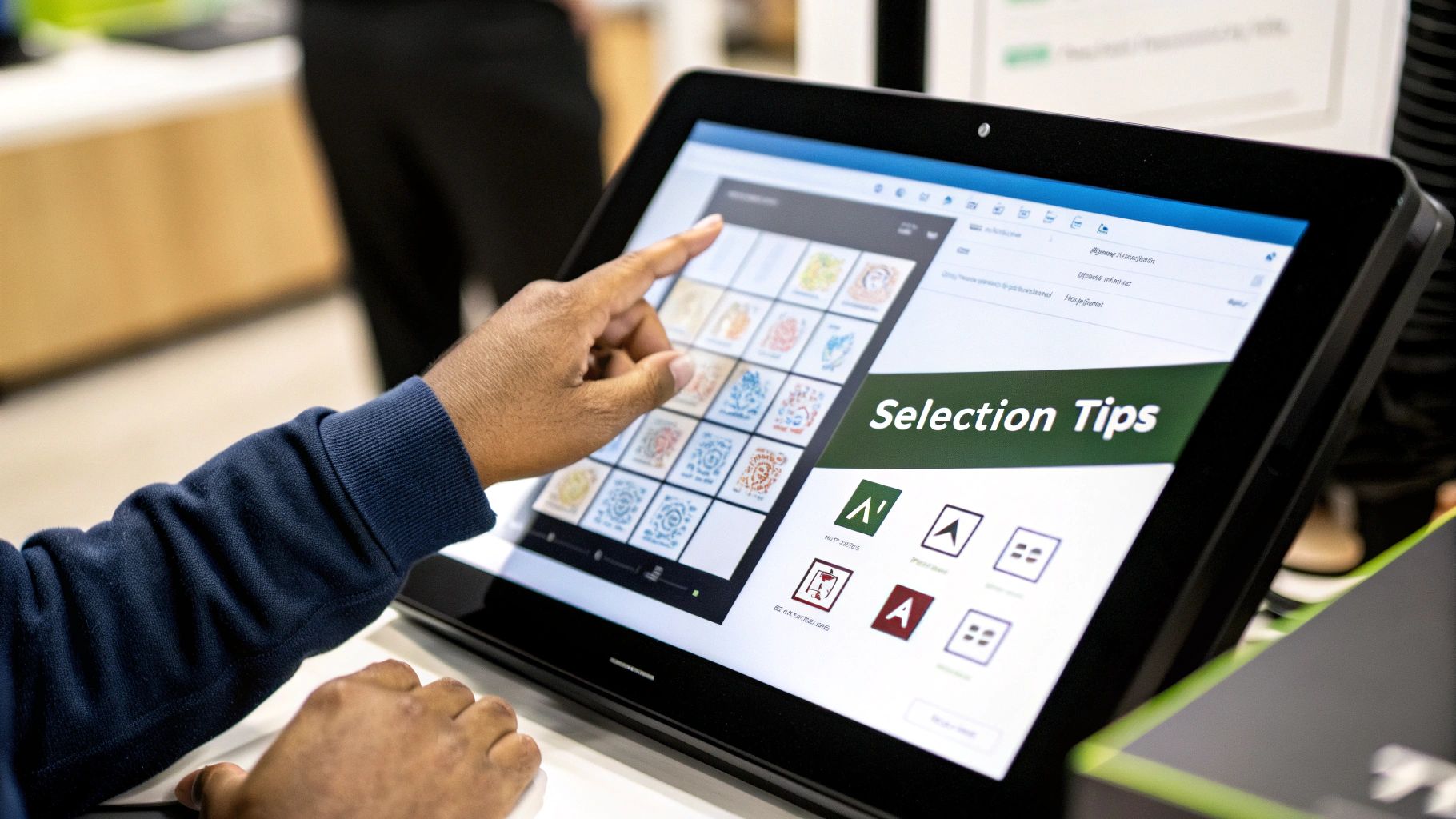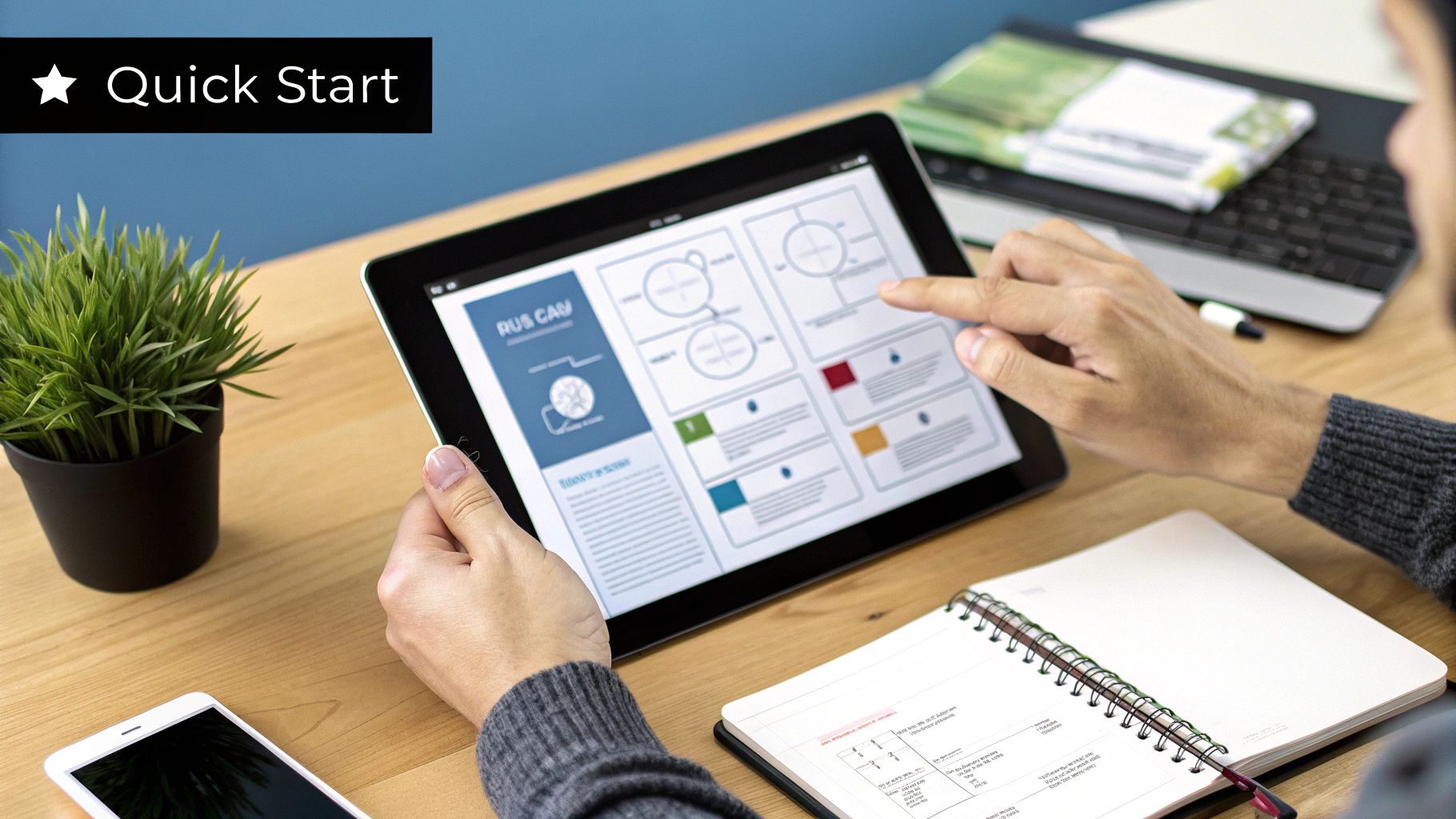A royalty-free AI image generator is a tool that uses artificial intelligence to turn simple text descriptions into one-of-a-kind visuals. Once created, you can use these images over and over again for different projects without ever paying ongoing fees—making them a powerful, on-demand alternative to traditional stock photography.
The New Era of On-Demand Visual Content
Think about the last time you needed a specific image for a blog post, a social media campaign, or a business presentation. Until recently, your options were pretty limited and often expensive. You either had to hire a photographer, spend hours digging through stock photo sites for a "good enough" match, or settle for a generic graphic that didn't really connect with your audience.
That old model was a real grind—defined by high costs, creative compromises, and confusing licensing agreements that felt like a legal trap.
But that entire process has been turned on its head. The rise of royalty-free AI image generators represents a massive shift in how we create and use visual content. Don't think of it as just another tool; picture it as your own personal digital artist, on call 24/7, ready to bring your wildest ideas to life in seconds. Instead of searching for what already exists, you can now create exactly what you need, right when you need it.
Shifting from Searching to Creating
The most fundamental change here is moving from a reactive to a proactive creative process. You’re no longer limited by the collections that stock photo companies decide to offer. This new approach is a game-changer for creators and marketers, offering some serious advantages.
Here’s what this shift really means for you:
- Unmatched Speed: You can generate a custom image in the time it takes to write a sentence. Creative cycles that used to take days or weeks are now cut down to minutes.
- Creative Freedom: Your imagination is the only real constraint. You can conjure up hyper-specific scenes, abstract concepts, or impossible scenarios that no camera could ever capture.
- Cost-Effectiveness: Say goodbye to the recurring fees of rights-managed images and the steep upfront costs of a custom photoshoot. With a platform like AI Media Studio, you can even start creating for free.
The real power of a royalty-free AI image generator isn't just making pictures. It’s about tearing down the wall between an idea and its visual execution. This frees you up to test, iterate, and achieve a level of creative specificity that was simply out of reach for most businesses before.
This guide will take you beyond the initial hype and give you a practical roadmap. We’ll break down how this technology actually works, what "royalty-free" truly means for AI-generated art, and how to evaluate different platforms to find the perfect fit. With this knowledge, you can confidently leave the sluggish, old methods behind and step into a new world of on-demand creative power.
How AI Image Generators Turn Words into Art

Have you ever wondered how a simple string of words magically becomes a detailed, one-of-a-kind picture? The process behind a royalty-free AI image generator isn't about following a rigid set of pre-coded rules. It's much more like teaching a very bright student about the world through art and language.
Think of the AI as a 'digital dream interpreter.' It hasn't just memorized a massive library of photos. Instead, it has spent an incredible amount of time studying millions—sometimes billions—of image-and-text pairs to build an abstract, conceptual understanding of everything. It learns the essence of "dog" in thousands of different contexts, what defines a "cyberpunk aesthetic," and the specific feeling behind the word "serene."
So, when you type in a prompt like "a photorealistic image of a golden retriever wearing sunglasses on a beach," the AI doesn't just search for a photo that matches. It draws on its learned knowledge of each of those concepts—golden retrievers, sunglasses, beaches—and builds an entirely new image from scratch that fits your request. This is the key difference: it generates, it doesn't just retrieve.
The Magic of Diffusion Models
Most of the impressive image generators you see today are powered by a process called diffusion. It’s a fascinating method that works a lot like a sculptor, who starts with a rough block of marble and slowly chisels away until a clear figure emerges.
Here's how that process generally unfolds:
- Starting with Noise: The AI begins with a canvas filled with what looks like random static, almost like an old TV screen with no signal. This is pure, unstructured digital "noise."
- Gradual Refinement: Guided by your text prompt, the model starts to slowly clean up this noise, one small step at a time. It searches for patterns in the static that could vaguely match the concepts in your description.
- Shaping the Image: With each step, the image becomes a little less noisy and a lot more like your prompt. A blurry shape starts to take on the form of a dog; a patch of color begins to resolve into a sunset.
- Creating Coherence: This iterative process continues over and over until the noise has been completely replaced by a crisp, coherent image that lines up perfectly with your original idea.
The core idea is that the AI learns from vast datasets, but it doesn't copy from them. It deconstructs concepts into their fundamental elements and then reconstructs them into something entirely original. This ensures the visuals you create are unique to your prompt.
Why This Technology Is Growing So Fast
Once you understand this creative process, it's easy to see why the technology is advancing at such a breakneck pace. These systems aren't just getting better at recognizing things; they are becoming incredibly skilled at the creative act of synthesis—of putting ideas together in new ways.
This rapid improvement has kicked off massive market growth. The global AI image generator market, currently valued at around USD 418.5 million, is projected to explode to USD 2,633.2 million by 2035. This incredible expansion is all thanks to the power of deep-learning models that can produce anything from photorealistic scenes to abstract art. You can read more about the projected 18.2% annual growth of AI image generation tools to get the full picture.
This foundational knowledge helps you appreciate not just the power of the tool, but how to write more effective prompts to guide its creative journey.
Understanding Royalty Free and Commercial Use
Diving into image licensing can feel like you need a law degree, but it doesn't have to be that complicated. At the heart of most AI art platforms is the term royalty-free, a concept that's often misunderstood but is key to unlocking all that creative potential for your projects.
At its core, royalty-free means you pay for a license once—or in the case of many AI tools, get it included—and can use that image over and over without paying extra fees or royalties each time. Think of it like buying your favorite coffee mug. You buy it once, and you can drink from it every single day without paying the shop again. It’s a huge shift from the old, restrictive ways of licensing images.
But here’s the crucial part: royalty-free does not automatically mean you can use it for commercial use. Just because you can use an image repeatedly for your own stuff doesn't give you the green light to slap it on a product you plan to sell.
Permission for commercial use is a completely separate, and vital, layer of the license. It’s the difference between using a cool image on your personal blog versus putting it in a paid ad campaign or printing it on t-shirts for your online store. The stakes are way higher with business projects, and so are the legal rules.
Always Check the Terms of Service
So, how do you make sure you’re in the clear to use an AI-generated image for your business? The answer is always hiding in plain sight: the Terms of Service (TOS) for the specific AI image generator you're using. That document is your legal safeguard and ultimate guide.
Every platform plays by its own rules. One might grant full commercial use with its paid plans, while another could have tight restrictions. Never assume—always verify. Taking five minutes to read the TOS can save you from a world of headaches down the road.
For instance, a platform like AI Media Studio makes it crystal clear that images created with its premium plans come with full commercial rights. That gives you complete confidence to use your creations anywhere. Other tools might have more complex rules, so it’s essential to check before you hit publish.
AI Image Licensing Models Compared
To really appreciate why royalty-free with commercial rights is such a game-changer, it helps to see how it stacks up against other licensing models. Each has its purpose, but they serve very different needs.
| License Type | What It Means | Best For Commercial Use? |
|---|---|---|
| Royalty-Free | Pay once (or get for free) and use the image multiple times without additional fees per use. | Yes, but only if the platform's specific license explicitly grants commercial rights. Always check the fine print. |
| Rights-Managed | Pay a fee for a specific, one-time use. The cost depends on factors like placement, duration, and audience size. | Yes, but it's expensive and highly restrictive. It's common in traditional high-end advertising where exclusivity is key. |
| Creative Commons (CC) | A range of licenses that allow free use but often come with specific conditions, such as giving credit to the creator (attribution). | It depends. Some CC licenses (like CC0) are fine for commercial use, while others (like CC-BY-NC) explicitly forbid it. You must check the exact license type. |
This clear distinction is why finding a reliable AI image generator that offers straightforward commercial rights is so valuable. It strips away the guesswork and legal risks, letting you get back to what matters—the creative work itself. For a closer look, our guide on the best AI image generators breaks down the top platforms and what they offer.
The infographic below really drives home the practical advantages AI has over old-school methods, showing exactly why so many creators are making the switch.

The numbers don't lie. AI tools not only speed up production and slash costs but also give you a clear path to licensing compliance—a huge win for any business.
Evaluating an AI Image Generator for Your Needs

The market for AI image generation is absolutely booming. It’s not just hype—with a current valuation of around USD 349.6 million, the market is on track to explode to over USD 1.08 billion by 2030. You can see the full breakdown of this incredible growth in the market research report from Grand View Research.
That explosive growth means you’re flooded with options, each one promising breathtaking visuals. So, how do you pick the right one?
It’s about more than just the final image quality. The best royalty free AI image generator for you is one that fits your workflow, skill level, and creative goals. A super-powerful tool with a confusing interface will just slow you down. To make a smart choice, you have to look at the whole package.
Let's break down what truly separates a decent tool from a great one.
Core Features That Drive Creative Success
When you're comparing different platforms, try to look past the flashy examples on their homepages. What really matters are the practical, day-to-day features that will actually shape your creative process. The goal is to find a tool that gives you both simplicity and control.
Here are the essentials to look for:
- An Intuitive User Interface: The best tools just make sense from the moment you sign up. You shouldn't have to read a dense manual just to generate your first image. Look for clean layouts and a logical workflow, like the straightforward design you'll find in AI Media Studio.
- A Wide Variety of Art Styles: A good generator should feel like a well-stocked art supply store. Whether you need photorealistic images for a marketing campaign, clean vector graphics for a logo, or detailed 3D renders, having these styles built-in is a massive time-saver.
- Advanced Control Features: Once you get the hang of it, you'll want more say in the final output. This is where features like negative prompts (telling the AI what not to include) and precise aspect ratio controls become indispensable. After all, an image for an Instagram Story needs a totally different shape than a website banner.
A great AI image generator doesn’t just follow your instructions; it gives you the right set of controls to steer the creative process. It’s the difference between being a passenger and being the driver.
Technical Capabilities and Platform Support
Beyond the fun creative stuff, the technical side of a platform determines whether your creations are truly professional-grade. A low-resolution image might be fine for a quick brainstorm, but it’s a non-starter for a client presentation or a high-quality print.
Just as important is knowing you actually have the right permissions to use what you make. Before you commit to any platform, dig into their licensing terms. We've put together a detailed guide that explains the nuances of AI image usage rights to help you stay compliant and confident.
Be sure to consider these technical and support factors:
- High-Resolution Outputs: Can the tool generate images at a high enough resolution (like 2K or 4K) for what you need? Check if high-res generation is standard or a paid add-on.
- Upscaling and Editing Tools: Sometimes an image is almost perfect. Tools with built-in upscaling, inpainting (editing one part of an image), and outpainting (extending the canvas) can be lifesavers, preventing you from having to start over.
- Community and Support: Don't underestimate the value of a helpful community forum or a responsive support team. When you’re stuck on a tricky prompt, it's great to know there are people who can help. It’s a sure sign the company cares about its users.
By carefully weighing these functional, technical, and legal details, you can choose a royalty free AI image generator that doesn’t just make pretty pictures—it becomes a true partner in your creative work.
How to Craft Prompts That Get Amazing Results

Getting a fantastic image from a royalty-free AI image generator isn't about knowing some secret code. It’s a skill, and it’s one you can absolutely master. Think of it like you're directing an incredibly talented artist who just happens to be very literal. The better your directions, the better the final piece.
Your text prompt is your creative brief. A vague request like "a car" will get you a generic, unpredictable image. But a detailed, thoughtful prompt? That’s how you get a stunning, specific result that looks like it was pulled straight from your imagination.
Let's break down how to go from a simple idea to a powerful prompt that delivers exactly what you want.
From Simple to Specific: A Prompt Formula
So, you need an image of a car. Just typing a car into the generator is a roll of the dice. You might get a boring sedan, a cartoon jalopy, or something from a sci-fi movie. To take control, you need to start layering in the details.
A powerful prompt usually follows a simple, effective formula:
- Core Subject: Start with the star of your image.
- Descriptive Adjectives: Give it character. What does it look like?
- Setting & Environment: Where is your subject?
- Style & Medium: Define the artistic look and feel. Is it a photo? A painting?
- Composition & Lighting: Tell the "photographer" how to shoot it.
Let's put this into practice.
- Before:
a car - After:
A vintage red convertible sports car on a coastal highway at sunset, cinematic lighting, hyperrealistic, wide-angle shot.
See the difference? The "After" prompt leaves nothing to chance. It tells the AI the exact type of car, its color, the location, the time of day, and even the camera work. This is how you guide the AI from a fuzzy concept to a finished masterpiece.
Building Your Prompt Vocabulary
To really level up your prompting skills, you'll want to build a "vocabulary" of artistic and technical terms. You don't need a degree in art history, but knowing a few key phrases can make a world of difference.
Here are a few categories of terms you can start mixing and matching:
- Art Styles:
vaporwave,art deco,minimalist,steampunk,cyberpunk,gothic - Mediums:
oil painting,watercolor illustration,3D render,vector graphic,charcoal sketch - Lighting:
cinematic lighting,soft light,dramatic lighting,studio light,neon glow - Camera Angles:
wide-angle shot,close-up,macro shot,bird's-eye view,dutch angle
Treat your first attempt as a starting point, not the final product. Iteration is a core part of the creative process. If an image isn't quite right, don't just start over—tweak your prompt and try again.
For instance, if your first image feels a bit flat, add "cinematic lighting" or "dramatic shadows" to your prompt. If your subject is too far away, add "close-up shot." Each little change refines the output, bringing you one step closer to the image in your head.
Learning to iterate is the real secret sauce. You can find tons of great AI image prompt examples that show how tiny tweaks can lead to huge improvements. Keep refining your prompts, and you'll be directing your AI artist with precision and confidence in no time.
The Future of AI-Powered Visual Creation
The tools we have our hands on today are really just the opening act. AI for visual creation is moving from a fun novelty to an essential piece of the puzzle for businesses everywhere. The speed of its growth and the investment pouring in shows just how critical these platforms are becoming if you want to stay relevant in a market that runs on visuals.
We're seeing this trend play out in a big way in specific regions. North America, for instance, is leading the charge, holding 36.1% of the global AI image generator market—a slice worth about USD 419.2 million. This isn't surprising, given the high rate of tech adoption and major buy-in from both creative and business sectors. You can dig into more of this data and learn about the U.S. market's growth on Dimension Market Research. It’s a clear sign that AI content creation is on its way to becoming standard business practice, not just in North America, but around the world.
What’s Just Over the Horizon
The royalty free AI image generator is evolving fast, pointing toward a future where our creative workflows are more connected and powerful than ever. The lines between different types of media are blurring, which is fantastic news for creators and marketers looking for new ways to engage their audiences.
We’re standing on the edge of some incredible breakthroughs:
- AI-Driven Video Generation: This is the next big thing. Soon, you'll be able to turn a simple text prompt into a short video clip. Think about creating a quick product demo or a slick social media animation just by describing what you want to see.
- Hyper-Realistic Models: AI is getting scarily good. Before long, it will be able to generate images so lifelike they’re impossible to tell apart from professional photos. This opens up a whole new world of quality for commercial projects.
- Seamless Workflow Integrations: Get ready for AI image generation to be built right into the tools you use every day, like Adobe Photoshop or Figma. This will make the whole process of creating feel more natural and fluid.
The big takeaway here is this: these tools are unbelievably powerful, but true skill comes from understanding both the creative side and the legal side. The creators who stand out will be the ones who master crafting great prompts while respecting the licensing that comes with the images.
Your Invitation to a New Creative Era
This isn't just another tech fad. It's a fundamental shift in how we think about and create visual content. The people and businesses who jump in and start learning this technology now are the ones who will lead the pack tomorrow.
If you wait, you risk getting left behind. The best time to start playing with a royalty free AI image generator was yesterday. The second-best time is today. By diving in, you can build the skills to innovate and create with a speed and freedom we could only have dreamed of just a few years ago.
Got Questions? We’ve Got Answers
Stepping into the world of AI image generation can feel a little confusing at first. Let's clear up some of the most common questions that creators and businesses ask when they start exploring tools like a royalty-free AI image generator.
Can I Legally Use AI-Generated Images for My Business?
Yes, absolutely—as long as you’re using the right platform. The key isn't just the term "royalty-free," but whether the service explicitly gives you a commercial use license.
This is non-negotiable for any business. For example, AI Media Studio is crystal clear in its terms: images made with our premium plans come with full commercial rights. That’s your green light to use them for marketing, on products, or anywhere your business needs them. Always double-check the terms of service to be safe.
Are AI-Generated Images Copyrighted?
This is where things get interesting, as the law is still catching up. The current take from the U.S. Copyright Office is that an image created entirely by an AI, without major creative input from a human, can't be copyrighted by the user. The reasoning is that the "author" is the machine, not a person.
Key Takeaway: You might not be able to copyright the image yourself, but the platform's license is what matters. It grants you the right to use the image. This is exactly why choosing a generator with a solid commercial license is so crucial—it protects your ability to use the asset, even if you don't "own" it in the traditional copyright sense.
What Kind of Image Styles Can I Create?
You’re not stuck with just one look. A powerful royalty free AI image generator is like having an entire art department at your fingertips. Most modern tools let you create an incredible range of visuals just by adding a style descriptor to your prompt.
A few popular styles you can generate include:
- Photorealistic: For images so real they look like they were captured with a professional camera.
- Vector Art: Clean, scalable graphics that are perfect for logos, icons, and web design.
- Watercolor or Oil Painting: Get that classic, handcrafted feel for illustrations and artistic projects.
- 3D Renders: Create visuals with realistic depth and texture, great for product mockups and architectural concepts.
- Anime and Cartoon: Bring popular animated and comic-book styles to life.
Will I Get the Same Image as Someone Else?
It's practically impossible. Even if two people type the exact same prompt down to the last letter, the AI will generate a unique image every single time. The process kicks off with a random digital "seed" for each request, which guarantees a one-of-a-kind result.
This ensures your visuals are genuinely original. If you want to be extra sure, just change a single word in your prompt. You'll get a completely different image, opening up a world of endless creative variations.
Tired of scrolling through endless stock photo libraries? It's time to create the exact visuals you've been imagining. AI Media Studio gives you over 50 art styles, full commercial rights, and a simple platform designed to make pro-level image generation easy for everyone. Start creating for free today at ai-media-studio.com.